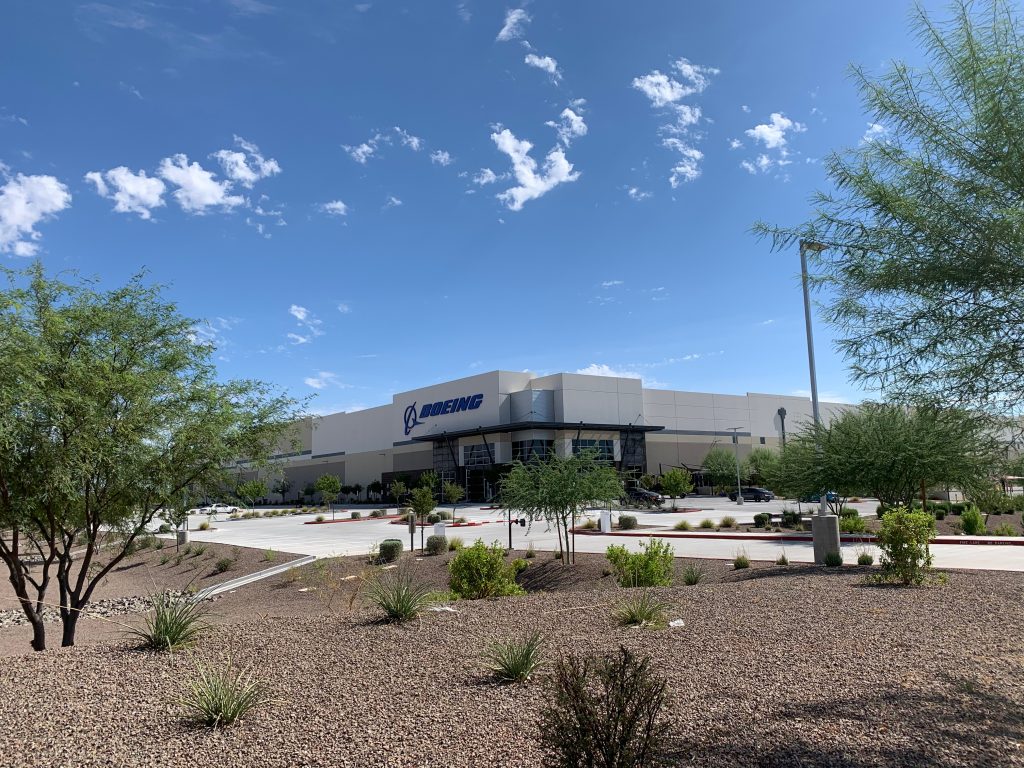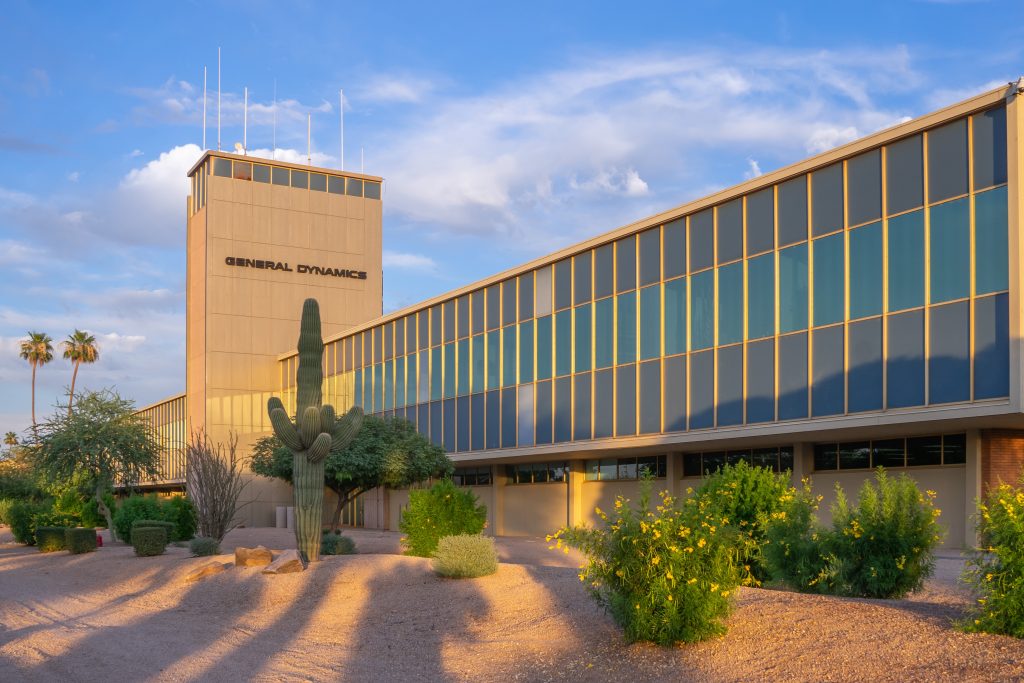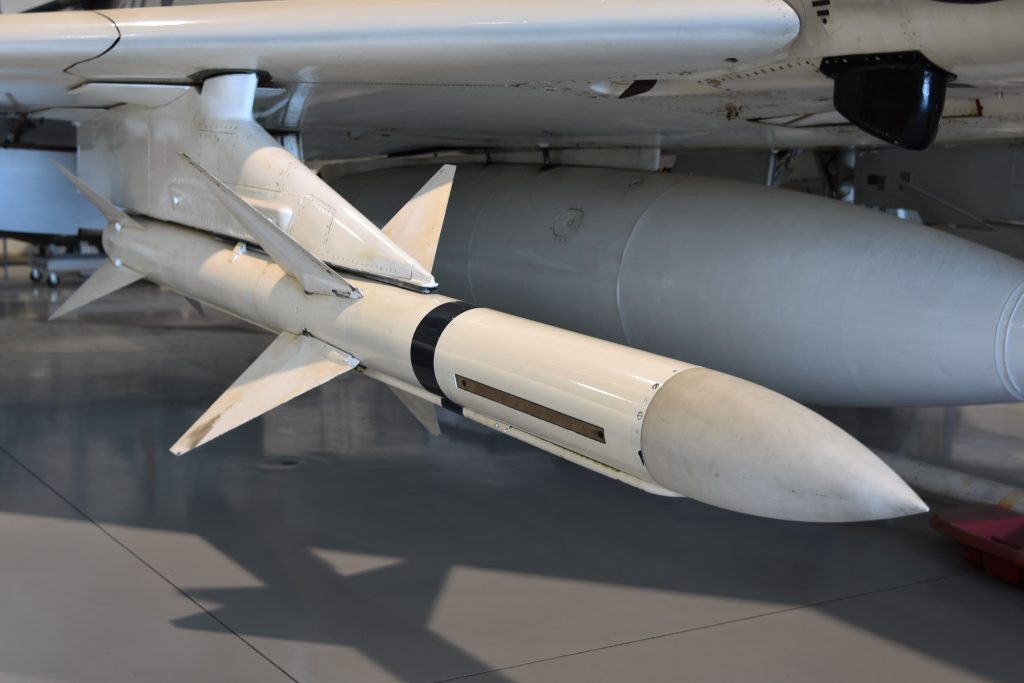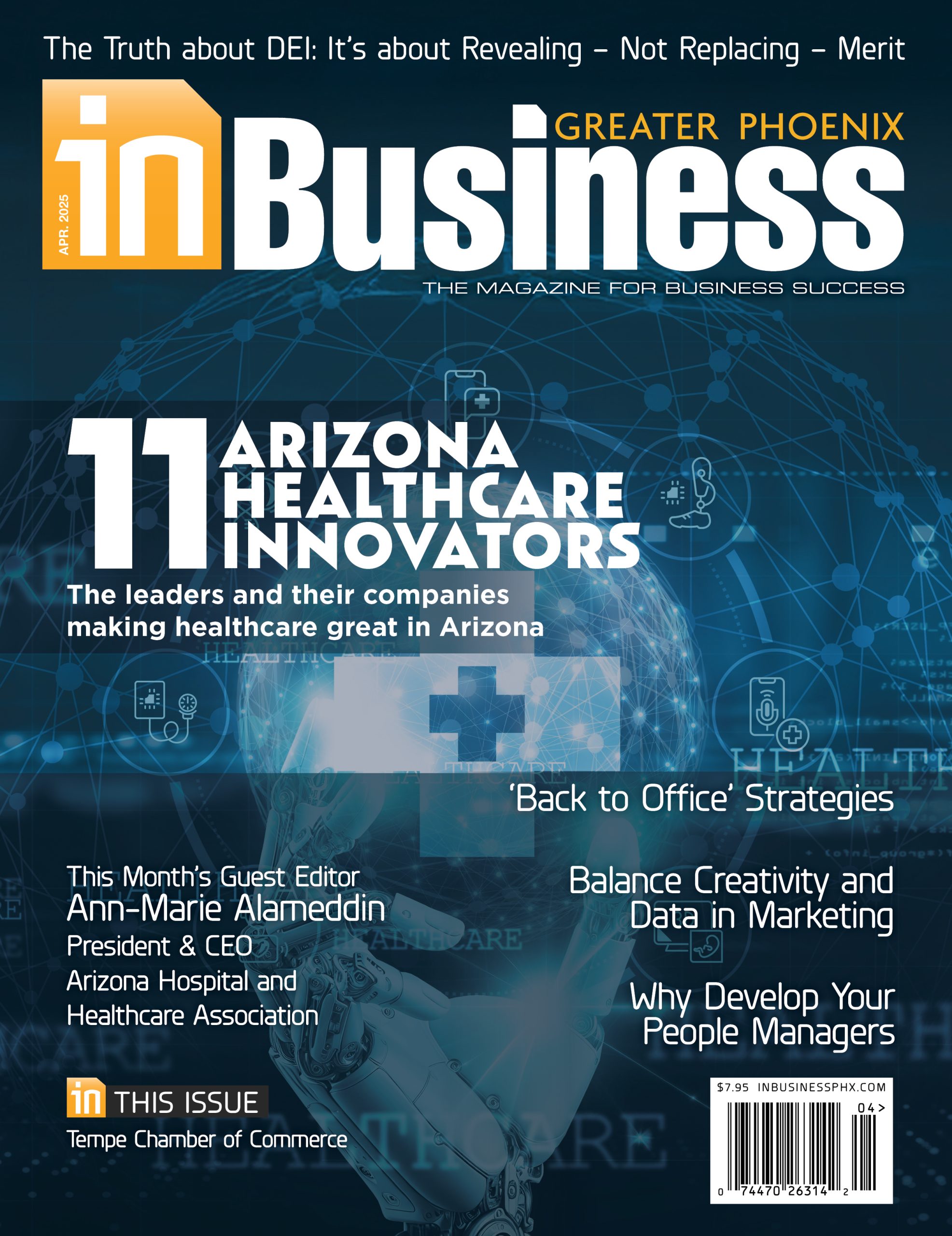Aerospace & defense is interwoven in our state’s economy with its extensive range of manufacturing and engineering, from aircraft to optics, weapons systems to drone detection, and parts to software.
Four of our major A & D businesses help us gain a snapshot view of the current strength of the industry and what bodes for the future.
 Boeing Headquarters in Avondale, Arizona
Boeing Headquarters in Avondale, Arizona
Boeing, in Arizona for more than four decades, has established itself as a cornerstone employer here. Its Mesa facility is the production hub for the AH-64 Apache program but also houses fabrication centers specializing in electrical wire bundles, composites and metals. “With nearly 5,000 employees and an estimated $1 billion in annual economic impact, Boeing Arizona taps into a robust network of local suppliers to deliver goods and services to a worldwide market,” says Mark Gaspers, director of government operations for the Central region. “Boeing’s operations significantly contribute to the aerospace industry, focusing on innovation and sustainability while ensuring a strong talent pipeline to support growth.”
Honeywell’s presence here dates back to 1942. Its Aerospace business unit builds aircraft engines, auxiliary power units and avionics systems among which are flight management and safety systems, navigation systems, space and satellite systems, control systems, wireless connectivity and SATCOM systems, and power systems — for a variety of aircraft. Honeywell Aerospace hardware and software solutions enable next-generation lifesaving runway safety technologies, help modernize air traffic control systems and enable seamless wireless connectivity for better inflight experience.
“Headquartered in Phoenix, Honeywell Aerospace products and services are found on virtually everything type of aircraft,” says Ben Driggs, chief commercial and strategy officer of Honeywell Aerospace Technologies. “Honeywell technology helps enable everything from commercial airliners and business jets to general aviation and military aircraft like the F-35. Honeywell Aerospace technology has also flown on every U.S.-crewed space mention since NASA’s inception. Honeywell Aerospace is also involved in developing technologies for the emerging Advanced Air Mobility market, including electric propulsion and autonomous systems.” Reporting the company’s Aerospace business generated $15.5 billion in revenue in 2024, he notes, “Honeywell is in the process of separating into three companies, with Honeywell Aerospace slated to become an independent, publicly traded company based in Phoenix, Arizona, in the second half of 2026.”
 Honeywell Aerospace F-35A Lightning II fighter jet
Honeywell Aerospace F-35A Lightning II fighter jet
Employment Needs and Talent Pipeline
Raytheon currently employs more than 12,500 people in Arizona. “We have seen growth in demand centered around our manufacturing operations — production and factory support roles — in Tucson driven by increased customer demand and the program lifecycle, with several larger programs transitioning from development to production,” says Sam Deneke, president of Raytheon’s Air and Space Defense Systems business. The company’s current openings in Tucson are primarily assembly/test and production workers, which account for nearly half of current open positions. Another quarter of open positions are early professional roles, and a quarter are senior professional roles, primarily for E&E, mechanical and systems engineers.
Gaspers cites aerospace engineers, software developers and manufacturing technicians as among the diverse range of skilled professionals Boeing needs to maintain its competitive edge, and notes Boeing’s proactive approach of collaborating with partners from a cradle-to-career perspective. “We recognize how critical it is to engage students from a young age to encourage curiosity and help build foundational skills in STEM fields, as well as build career pipelines for other critical support functions like supply chain and finance,” he says. “We also reap the benefits of Arizona’s robust higher education system.”
He credits these partnerships for enabling Boeing to create a strong talent pipeline that meets the evolving demands of Arizona’s growing aerospace and defense sectors. “We are proud of our strong relationships with local partners, including the Mesa Public School District, Arizona Science Center, Arizona State University, University of Arizona, Maricopa County Community College District and Embry-Riddle Aeronautical University.”
Boeing’s involvement in internship and STEM training programs provides hands-on experience as well as pathways to employment. A notable example Gaspers points to is the partnership between Honeywell Aerospace Technologies and the East Valley Institute of Technology to establish a STEM Academy in Mesa (https://www.evit.edu/career-training/programs/stem-academy). “This academy offers training and certifications for high school students, aligning curriculum development with industry needs to strengthen Arizona’s aviation and advanced manufacturing workforce pipeline. By collaborating early in curriculum development, we ensure that training meets current and emerging industry demands, creating valuable opportunities for prospective students across the region.”
Raytheon likewise sees value in working with the school system. According to a Deneke, “We are partnering and investing in our K-12 system and higher education, particularly University of Arizona and Arizona State University, to ensure we have a ready workforce that can step onto our campus day one. That allows us to bring and keep jobs here, which strengthens the economy and our community.” A few of Raytheon’s other partnerships are State of Arizona @Work, Veterans Administration and local Arizona military bases (David Monthan Air Base and Luke Air Base). “We partner with them in a variety of capacities, including hiring events, training/education and internships.”
General Dynamics is also focused on the pipeline for talent. “We have a comprehensive summer intern and college hiring program, a local scholarship program and active military outreach to attract top talent. We have many community partnerships that help us connect with job seekers to share the career opportunities at GDMS,” says Chris Brady, General Dynamics Mission Systems president, naming some of the company’s key initiatives to ensure it has the diverse talent needed to sustain growth and positively impact its economic strength. “At General Dynamics Mission Systems in Scottsdale, we frequently hire for a range of positions, including software engineers, systems engineers, hardware engineers, program managers, manufacturing production operators, and engineering technicians.”
With approximately 7,500 people in its employ in and around Phoenix, Honeywell focuses on several growth areas to meet current and future workforce needs. “To ensure that the workforce is prepared, we have partnered with the state’s educational system, particularly in skilled advanced manufacturing and engineering,” Driggs says. “For instance, we have developed training programs with the Maricopa Community College system and local high schools. Additionally, our collaborations with Arizona State University, the University of Arizona, and other institutions are vital for creating a robust talent pipeline.” He notes Honeywell is hosting more than 300 high school and college interns in Arizona this summer, “highlighting our commitment to nurturing future talent.”
With a growth strategy that also extends to such key employment areas as digital and AI skills, engineering, manufacturing and operational support, Honeywell is implementing upskilling and reskilling initiatives, fostering partnerships with educational institutions and launching mentorship programs. “A strategic talent framework is being developed to align workforce capabilities with our business strategies, emphasizing critical skills and innovative learning experiences,” Driggs says.
Specialized training programs are part of the plan at General Dynamics Mission Systems, according to Brady, who names the Engineering Leadership and Manufacturing Leadership programs. Noting that, additionally, GDMS University provides ongoing education and career growth opportunities for GDMS employees, he says, “These efforts help us maintain a skilled workforce that meets the evolving needs of our company and supports our long-term success.”
Many of Raytheon’s efforts are aimed at military veterans, with veteran and military organizations a big part of the workforce partnerships mentioned above. And, says Deneke, “We also provide a variety of trainings to our Skillbridge interns, who work for us while transitioning out of the military, to include things like résumé, job search, resiliency and negotiation training.”
Another important initiative Boeing is involved in is the Future48 Workforce Accelerator, a partnership involving Governor Hobbs, the Arizona Commerce Authority, the Maricopa County Community College District, Chandler-Gilbert Community College and Honeywell. Providing hands-on training to prepare students for in-demand careers in aerospace and defense manufacturing, “The Future48 Workforce Accelerator combines expert-led instruction with practical training to address the growing need for highly skilled aviation mechanics and technicians,” Gaspers says. “The training facility will feature cutting-edge labs equipped with industry-standard tools and flexible spaces that facilitate seamless transitions between lectures and hands-on learning, including electrical assembly, mechanical assembly and wiring.”
 General Dynamics on McDowell Rd. in Scottsdale, Arizona
General Dynamics on McDowell Rd. in Scottsdale, Arizona
Economic Impact – Employment and Beyond
While pointing out that Honeywell employs approximately 7,500 people in Metro Pheonix and has a total estimated payroll of close to $1 billion annually, Driggs notes, “The economic impact of Honeywell Aerospace in Arizona goes well beyond the people we employ. We make purchases in excess of $650 million per year from numerous Arizona-based suppliers.
“We also make an impact through technical co-innovation with our Arizona-based customers and suppliers,” he adds. “We help enable the state’s aerospace eco-system. This high-skill training creates impact beyond just payroll as it increases their demand and competitiveness in the job market.”
Gaspers notes Boeing’s economic impact in Arizona also extends far beyond job creation, as the company generates substantial revenue that strengthens the overall economy of the Valley and the state. For example, he shares, “The AH-64 Apache helicopter program is vital for the U.S. armed forces and allied partners, with its development, research, testing and production in Arizona significantly boosting the state’s economy.” Statewide, the Apache program provides work for a total of 49 businesses, sustains approximately 13,000 family-supporting jobs, and generates an estimated $667 million in economic impact. “In Mesa alone, Apache provides work for thousands of machinists, assemblers, engineers and more, and work today continues to develop a modernized Apache that will keep our community focused on protecting our servicemembers for decades to come.”
Reporting that approximately 1,300 Apaches are currently in operation worldwide, serving 18 nations, and that, to date, Boeing Mesa has delivered more than 2,800 Apaches to global customers, Gaspers says, “We continue to see strong, persistent global demand. With the AH-64E in production through the 2030s, the Apache is set to remain the U.S. Army’s and its partner nations’ primary attack helicopter into the 2060s. Follow-on orders, upgrades, and modernization efforts will ensure the Apache remains in production well into the future.”
General Dynamics Mission Systems’ statewide supplier profile includes approximately $340 million in supplier spend in 2022 through 2024, according to Brady, who reports that approximately 250 Arizona companies currently support GDMS, with 32% large companies and 68% small companies. “It’s the largest General Dynamics Mission Systems site both in number of employees (more than 2,600) and campus size,” he says. With its global reputation for mission-critical, precision electronic systems, it is a major facility for design, engineering, production and testing. Its highly educated and experienced workforce includes approximately 1,400 engineers, and 1,650 of its total workforce of more than 2,600 hold bachelor’s or advanced degrees.
Reporting Raytheon’s spend of $637 million from January 2024 through June 2025, Deneke notes, “We impact the entire supply chain ecosystem through our 600-plus suppliers statewide.” Not to mention its volunteer and philanthropic efforts: Employees of RTX overall in Arizona — which includes Pratt & Whitney and Collins Aerospace along with Raytheon — dedicated 32,000 volunteer hours in 2024, contributing more than $1.1 million in value to nonprofits (as calculated by Independent Sector’s assessment of $34.79 as the current estimated national value of each volunteer hour), and RTX contributed more than $15 million to support local and national nonprofits in Arizona, aiming particularly to improve access to STEM education, enhance community resilience and honor those who serve.
Raytheon’s own footprint in Arizona has grown by about 88,000 square feet since 2022. Says Deneke, “We are actively assessing future growth opportunities in the region. With a current footprint of 4.7 million square feet, this highlights our substantial presence and commitment to the state.”
Gaspers, while crediting Boeing employees with actively contributing time and resources to support STEM education, veterans and various workforce initiatives through partnerships with Arizona nonprofits, points out that Boeing also stimulates local economies through direct spending on goods and services, along with indirect benefits to suppliers and contractors. “Our commitment to research and development positions Arizona as a hub for aerospace innovation, attracting further investment and enhancing the state’s industry reputation. This growth leads to increased tax revenues and improved quality of life for local communities.” And he notes that Arizona has become the premier location for rotorcraft development and modernization, supported by a robust manufacturing sector and the U.S. Army’s test center at Yuma Proving Ground.
 Mesa Arizona 10-30-2021 Raytheon Sparrow missile under the wing of a military jet
Mesa Arizona 10-30-2021 Raytheon Sparrow missile under the wing of a military jet
Ensuring Continued Strength and Impact
“The U.S. aviation industry is calculated to create a trade surplus of over $100 billion annually for the country, and Arizona aerospace companies are significant contributors to that trade surplus,” says Honeywell’s Driggs. He believes the key to Arizona maintaining the great position it has in this industry is for companies, governments (at all levels — federal, state and local) and educational institutions to work together to encourage policies that support the industry and ensure that Arizona residents have the right skillsets.
“Additionally,” Driggs says, “Arizona also needs to continue to be a good host for the operators of aircraft, maintenance facilities and training schools. Our airports and the rest of the aerospace infrastructure helps to enable the state’s aerospace manufacturers.”
Observing that General Dynamics Mission Systems’ products, payloads and systems are deployed on hundreds of platforms across all warfighting domains, Brady sees nearly all domains experiencing a proliferation of platforms and capabilities. “And we are on pace to support our customers across these fronts from our Scottsdale site,” he says. “Consistent with the priorities of the administration and our customers, we are focused on crypto modernization to safeguard missions and secure critical information, proliferated space to enhance warfighter responsiveness and advantage, and avionic electronics essential for autonomous collaboration. Our expansion opportunities center on areas where we possess a mix of discriminating technology, mission understanding, and technical expertise to address emerging threats and warfighter needs.”
Brady points to investments in helping small businesses become compliant with upcoming Cybersecurity Maturity Model Certification requirements as a strategy to help set up small businesses in Arizona to be ready to work with large prime contractors in the defense industry. He cites the Arizona Manufacturing Extension Partnership center as a great resource for helping small businesses. Says Brady, “Businesses becoming compliant with defense cybersecurity requirements will be attractive and could help drive an increase in business for suppliers in the state.”
Pointing to the valuable employment opportunities and economic growth driven by Boeing’s operations, Gaspers says Boeing is committed to shaping the future workforce and establishing a strong foundation for the aerospace and aviation sectors. “Collaboration among the company, local communities and government entities will be crucial in creating a prosperous aerospace landscape for years to come,” he affirms.
Gaspers credits the State of Arizona for prioritizing key areas such as workforce development, support for innovation and research and development, infrastructure enhancement, and the maintenance of a business-friendly environment to ensure the continued strength of the aerospace sector. “Creating a favorable business environment is crucial for encouraging investment and innovation,” he says, adding, “Industry organizations also play a vital role in facilitating collaboration among businesses, educational institutions, and government entities, driving growth and innovation within the sector.”















